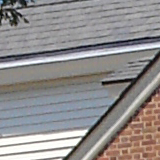Sony DSC-M1: Good Video, Disappointing Pictures
by Stephen Caston on June 20, 2005 12:05 AM EST- Posted in
- Digital Camera
General Image Quality
For these pictures, the camera was reset to its factory default setting. Then, it was set to its highest quality recording setting. The pictures were then taken in Auto mode unless stated otherwise. Portrait-style images have been rotated using Irfanview's "lossless operations". Click on a thumbnail to view the full-size image. All images are in sRGB color space.  Click to enlarge. |
 Click to enlarge. |
 Click to enlarge. |
 |
 |
 |
 Click to enlarge. |
 Click to enlarge. |
 Click to enlarge. |
 |
 |
 |
Overall, the image quality of the DSC-M1 is fairly average. In the first two samples above, the M1 demonstrates that it is capable of capturing a decent amount of detail. However, the details are characterized by a fuzzy and muddy appearance. In both pictures, even though the subjects are in focus, the details appear very soft. In the third and fourth samples, the M1 reveals another common problem - JPEG artifacts. We were pretty surprised to see this considering the relatively large file sizes. Although we spotted JPEG artifacts more frequently in shadow areas, they are also visible along fine details in nearly every picture that we took. In the fifth sample, the M1 proves capable of taking very detailed macro shots through the use of the Magnifying Glass mode. In the final sample, we used the ordinary Macro mode. Although the flowers are in focus and aesthetically pleasing, it is also very obvious that the camera has oversaturated the red channel causing clipping. We recommend shooting in Program mode where the saturation can be adjusted. Again, we weren't incredibly impressed with the image quality of the DSC-M1. However, we were happy to see that there were no real problems with purple fringing or jaggies. Most people will find the image quality of this camera acceptable for prints up to 8x10", but anything larger and you will probably notice the soft details and JPEG artifacts.
Twilight mode
 (ISO 100, 1 sec., f/3.5) Click to enlarge. |
 |
In Twilight mode, the M1 is limited to maximum exposures of 2 seconds. In our 1-second exposure above, the M1 proves that it can capture a significant amount of detail. However, just as we found with our daylight images, the details are soft/fuzzy. Again, we are surprised to see so much noise at ISO 100.
Movie Mode
 (640x480, 30 fps) Click to view. |
We recommend using VLC to play this file if you are having difficulties viewing it.
As you can see by our sample clip, the image quality is pretty good. However, the real advantage that the M1 has over traditional MPEG-1 videos is the size of the resulting file. The M1 sample video file is only 4.98 MB (14 seconds) compared to the 18.5 MB (10 seconds) file size that we saw on the Canon SD300. With our 512 MB Pro Duo card installed, the M1 indicates that we have 21 minutes and 41 seconds of video available at 640x480 and 30 fps. In addition to the option to use the optical zoom while recording, you can also select the white balance, exposure compensation, and image effects (B&W and Sepia) for video clips.










21 Comments
View All Comments
Gatak - Thursday, June 23, 2005 - link
#14, #11:My mistake. I read up on the NTSC standards. Originally they wanted 60Hz to avoid interference from the 60Hz power lines and also to use as syncronization for some camcorders. But they later choose 59.94Hz. The old b&w TV was 60FPS though.
Still, 59.94 or 29.97Hz seem strange to me. Converting a 24FPS FILM source would work just nice to 30 or 60FPS. (24x1,25=30, 48x1,25=60). The whole concept of using telecine is horrid to me:
1) reduce speed from 24fps to 23.976fps
2) split frames into fields
3) insert one new field every 4 fields.
4 playback with jerkiness!!!
Why not keep the 60Hz and at least remove step 1 in this list?
At least with PAL you would only have the first step, although they use 4,17% speedup instead. Some say it is worse, but I think it renders motion a lot better. Not to mention the almost 20% better resolution of PAL.
Locut0s - Wednesday, June 22, 2005 - link
My original quip about "multi-use" products could probably use a little clearing up. I am not against the idea of a product that integrates more than one feature. And in fact there are examples of products that I own that do just that and that I am happy with, like the printer/scanner/copier here. However my experience is that more often than not features are tacked onto products not to add another good feature but to add another line to the "features" list for marketing. I too would be happy with a video camera that takes sub par but still very good stills. But more often than not you end up with a video camera that not only takes sub par stills but they are blury and the feature seems like an afterthought, barely integrated with the rest of the features and cumbersome to work with in the software.PrinceGaz - Tuesday, June 21, 2005 - link
I'm cool with devices that do more than one function, but they must do every function well else in my opinion it is a non-function. So for instance the nGage which combined a baadly designed game console, with a cumbersome mobile phone, and a poor PDA, failed on every count and deservedly was a total flop as basically it was a device that did nothing well.A decent camera that takes substandard video-clips is fine by me, as it is still a camera and that is what I want from it. Similarly a camcorder with substandard still-image shooting (like the DSC-M1 reviewed) is still a camcorder and tbh I wouldn't really expect it to rival the still-image picture quality of a dedicated high mega-pixel camera. Oh sure it would be great if it did, but that's not of any real concern. It may have been best to review the DSC-M1 from the point of view of it being a camcorder, with higher resolution still image shots as just an extra feature. It certainly looks like a camcorder.
As for batteries, like I said I prefer AA's but as others have mentioned, they are larger because you generally need two to four to power most gadgets. I see NiMH AA capacities of 2400mAh are now readly available so thy continue to rise. Another reason to favour AA cells- as battery technology improves, you can get longer life cells cheaply. Certainly beats paying £30/$50 for some proprietary battery that is only available from the product manufacturer.
SDA - Tuesday, June 21, 2005 - link
Like johnmcl7, I prefer AAs. Definitely bigger, but they offer better battery life, and it's a lot cheaper and easier to replace dead NiMH AAs than dead proprietary Li-Ion batteries. Remember, Li-Ion batteries have a hard three-year limit on useful lifetime even if they're not used at all.. kind of sucks if they haven't been made in a while.I don't really care how many things a device does so long as it's reasonably good at all or most of them. Problem is, that doesn't hold true for a LOT of gear. Not that it doesn't for this, of course.
GoatMonkey - Monday, June 20, 2005 - link
It's pretty narrow to think that you should need a separate device for everything. Why should you? You can share common storage and batteries easy enough. You can share a common LCD screen and most of the control buttons. You can share a common CPU between the devices. Maybe if they would start to see these devices as small scale computers instead of just a camera, just a video recorder, just a phone, just an mp3 player, just a PDA, just a GPS...I don't see a reason that you can't have a device that is a common platform for each of these things where you could just attach the physical pieces that you want or need. There is no reason that the physical devices even need to be attached to the central platform if you're using Bluetooth, or whatever its successor is, Bluetooth 2 maybe?
I imagine an mp3 player that plays to a wireless bluetooth headset. Maybe that wireless headset could actually contain a processor a camera lense. I hate to say it, but I think people are going to be walking around looking like Borgs in about 3-5 years.
Johnmcl7 - Monday, June 20, 2005 - link
#9 - That attitude is just a bit daft, why limit devices to one function when they are capable of more than that? The expectation with combination devices is that they must be able to replace all the separate devices of which they attempt to offer the functionality of. I don't see it that way, I don't think my digital camera offers anything like the quality and functionality of a proper video camera, however I don't expect it to either - I'm glad to get some video capability, which is acceptable for me without having to carry another device with me.On the subject of batteries, I prefer AA batteries where possible, although on small cameras they can increase the size quite a bit. I went from the proprietary li-ion battery on the Fuji 4900z to 4xAA batteries in the S7000, it significantly increases the size and weight of the camera but it lasts far, far longer plus it's great being able to use any batteries, when I run out of power and really need some batteries I can just pop into a shop and grab some. Have to say, I'm very impressed with the battery in the Canon Ixus 500, it is a propietary battery but unlike other compact cameras I've used, the batterylife is surpsisingly good, I thought I would have to charge it up often but I only have to charge it occasionally, it's great that's always ready when I need it.
John
xt8088 - Monday, June 20, 2005 - link
#10, that's the standard frame rate for NTSC TV stanard(North American, Japan, Taiwan and etc use it).xt8088 - Monday, June 20, 2005 - link
Though, the Li-ion battery is smaller and lighter, that's more important for smaller P&S cameras.xt8088 - Monday, June 20, 2005 - link
#8: I agree. I was trying to say something like that. Proprietary Li-ion battery is way too expensive. But the calculation of capacity is more just mAH. You need to multiply the Votage to get correct capacity. 3.6V 680mAh 3.6V 680mAh almost the same as 1 NiMH AA 2000mAH@1.2V. Anyway, 2 or more such AA batteries have much more battery life than the proprietary one.stephencaston - Monday, June 20, 2005 - link
Gatak, yes this is the original video straight from the camera. I agree on your FPS concept...I would hope that advanced features like that are available in future MPEG4 cameras.